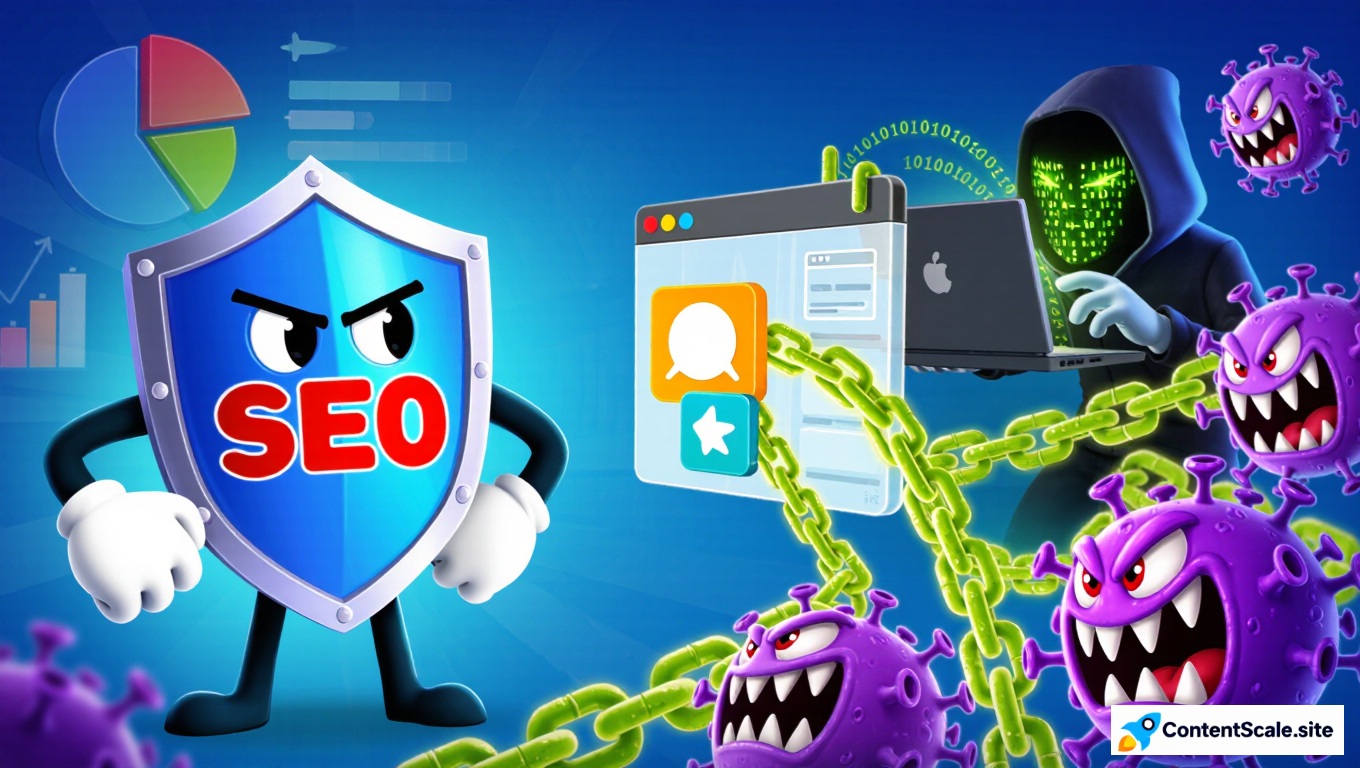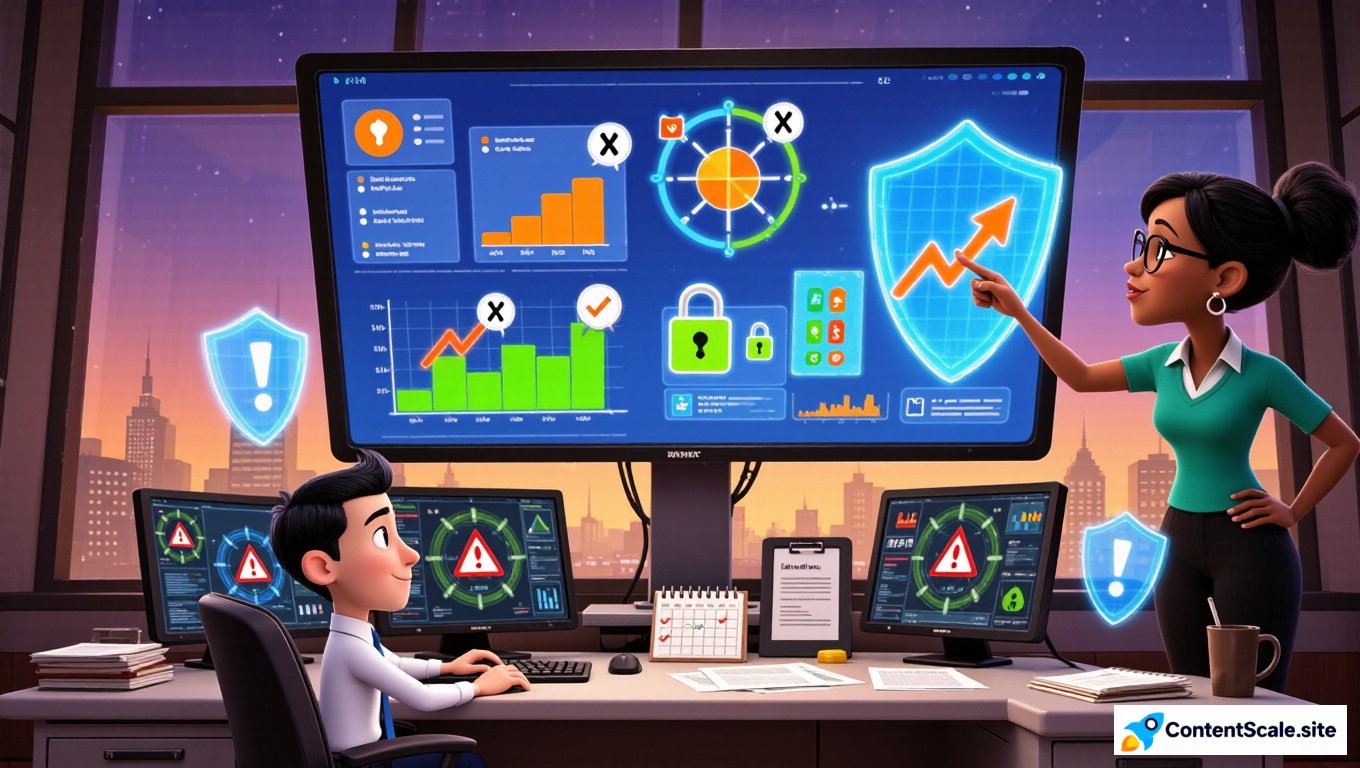Over 422,000 websites were hit with negative SEO attacks in 2024, costing businesses an average of $47,000 in lost revenue and recovery expenses. Negative SEO encompasses malicious tactics competitors or bad actors use to sabotage your search rankings – toxic backlink spam, content scraping, fake reviews, security breaches, and technical sabotage. Despite Google’s improvements detecting and neutralizing attacks, negative SEO remains effective enough that proactive monitoring and rapid response protocols are essential for protecting your online business.
Bottom Line: Negative SEO defense requires continuous monitoring systems detecting attacks within 24-48 hours, documented response protocols addressing each attack type, and preventive security measures reducing vulnerability. Early detection prevents 70% of potential damage, while rapid response enables 4-8 week recovery versus 6+ months for undetected attacks.
Table of Contents
What is Negative SEO?

Negative SEO refers to malicious tactics designed to harm competitors’ search engine rankings through attacks that violate Google’s guidelines. Unlike traditional SEO focused on improving your own website, negative SEO intentionally damages others’ websites to gain competitive advantage or exact revenge.
Common attack vectors include building thousands of toxic backlinks to trigger unnatural link penalties, scraping and duplicating content, hacking websites to inject malware or spam, creating fake negative reviews, and technical sabotage removing structured data or manipulating robots.txt files.
According to SEMrush’s 2024 study, 64% of websites with sudden ranking drops experienced some form of negative SEO attack as a contributing factor. While Google claims algorithmic protections devalue most attacks, real-world data shows attacks remain effective enough to warrant serious defensive measures.
8 Types of Negative SEO Attacks

Understanding each attack type’s characteristics, warning signs, and counter-strategies enables targeted defensive responses. Attackers often combine multiple techniques for amplified effect.
| Attack Type | Damage Speed | Detection Difficulty | Recovery Time |
|---|---|---|---|
| Toxic Backlinks | 2-8 weeks | Easy | 4-12 weeks |
| Content Scraping | 4-12 weeks | Moderate | 2-6 weeks |
| Fake Reviews | Immediate | Easy | 2-8 weeks |
| Hacking/Malware | 1-7 days | Easy | 1-4 weeks |
| Crawl Exhaustion | 4-8 weeks | Moderate | 2-6 weeks |
| Schema Manipulation | 1-2 weeks | Moderate | 1-3 weeks |
| Link Removal | 2-6 weeks | Hard | 4-12 weeks |
| Brand Hijacking | Immediate | Easy | 4-12 weeks |
1. Toxic Backlink Spam (Most Common)
The most common attack involves building thousands of low-quality, spammy backlinks to trigger Google’s unnatural link penalties. Attackers use automated tools creating links from adult sites, gambling networks, hacked websites, and known link farms.
Warning Signs: Sudden backlink velocity spike (100+ links in days), 95%+ exact-match anchor text, links from completely irrelevant niches, multiple links from same domains.
Defense Strategy: Weekly backlink monitoring, immediate disavow file creation, documentation for Google explaining external attack, preventive disavow files for known toxic domains.
2. Content Scraping & Duplication
Attackers copy your original content and publish it across multiple low-quality websites, creating duplicate content issues. At scale, this can trigger penalties or dilute ranking signals.
Warning Signs: Exact copies appearing on spam domains, scraped content with earlier timestamps, automated republishing minutes after you publish.
Defense Strategy: DMCA takedown notices, Google copyright removal requests, canonical tags strengthening original source signals, RSS feed protection.
3. Fake Negative Reviews
Coordinated campaigns creating multiple negative reviews on Google Business Profile, Yelp, or industry platforms damage reputation and local rankings. Sophisticated attackers create realistic-seeming fake reviews passing initial moderation.
Warning Signs: Multiple negative reviews same day, accounts with no history, generic complaints lacking specific details, contradicting documented service quality.
Defense Strategy: Flag through platform reporting, document evidence, respond professionally, encourage authentic positive reviews diluting impact.
4. Website Hacking & Malware
Security breach attacks inject malware, phishing pages, or spam content triggering Google Safe Browsing warnings and security penalties. Sophisticated attacks inject hidden spam links or pages evading initial detection.
Warning Signs: Hidden spam pages in Google Search Console, malware warnings, unexpected outbound links, unusual server resource usage.
Defense Strategy: Security monitoring with instant alerts, weekly malware scans, strong authentication, immediate cleanup protocols, Google security review requests.
5. Additional Attack Types
Crawl Budget Exhaustion: Creating thousands of fake pages forcing Google to waste crawl budget on worthless URLs instead of valuable content.
Schema Manipulation: Removing or corrupting structured data markup eliminating rich results and featured snippet eligibility.
Link Removal Campaigns: Impersonating your website to request removal of legitimate valuable backlinks from webmasters.
Brand Hijacking: Creating negative content ranking for brand searches – fake news articles, complaint websites, or impersonation pages.
Detection Protocols & Warning Signs

Early detection prevents 70% of potential damage from negative SEO attacks. Implementing automated monitoring systems and weekly manual reviews catches attacks before they trigger penalties or cause significant ranking losses.
Critical Warning Signs
- Backlink velocity spike: 100+ new links in 1-2 weeks (normal = 5-20 monthly)
- Traffic drop: 20%+ decline within 1-2 weeks without algorithm updates
- Security warnings in browsers or search results
- Multiple negative reviews within 24-48 hours
- Unexpected indexed URLs (thousands of spam pages in GSC)
Daily Defense Protocol (10 minutes)
- ☐ Check Google Search Console for manual actions or security issues
- ☐ Review Google Analytics for unusual traffic patterns (20%+ changes)
- ☐ Scan security alerts from Wordfence, Sucuri, or similar tools
- ☐ Monitor top 10 keyword rankings for unexpected changes
- ☐ Review Google Business Profile for new reviews
Weekly Defense Protocol (30 minutes)
- ☐ Run backlink analysis checking for toxic link spikes
- ☐ Review new backlinks in Ahrefs/SEMrush/GSC (last 7 days)
- ☐ Check Copyscape or Google for content scraping
- ☐ Verify structured data markup functioning correctly
- ☐ Review GSC Coverage for indexing anomalies
- ☐ Monitor brand mentions using Google Alerts
Toxic Backlink Response

Toxic backlink attacks require systematic identification and immediate disavowal. Responding within 2 weeks of attack detection prevents penalty triggers while delayed responses face 6-12 week recovery after penalties activate.
Emergency Response Protocol (First 48 Hours)
Hour 1-4: Initial Assessment
- Export all new backlinks from last 30 days using Ahrefs, SEMrush, or Google Search Console
- Identify unusual concentration patterns and spam scores
- Document attack characteristics with screenshots
Hour 13-24: Immediate Disavow Submission
- Create emergency disavow file containing obvious attack domains
- Use domain-level disavows for entire toxic networks
- Submit to Google Disavow Tool immediately
When to Skip Removal Attempts
Skip Directly to Disavow If:
- Attack involves 500+ links (removal requests futile at scale)
- Links from obvious spam domains (porn, gambling, hacked sites)
- Attack is ongoing with new toxic links appearing daily
- Evidence suggests coordinated malicious campaign
Content Scraping Defense

Content scraping creates duplicate content issues confusing Google about original sources. While Google usually identifies originals correctly, extensive scraping can dilute authority signals.
DMCA Takedown Protocol
- Identify Hosting Provider: Use WHOIS lookup or WhoIsHostingThis.com finding where scraped content is hosted
- Send DMCA Notice: Use template from dmca.copyright.gov documenting infringement with URLs, dates, sworn statements
- Follow Up: Hosting providers must respond within 72 hours legally; follow up if no response within 1 week
Google Copyright Removal
Request Google remove infringing URLs from search results through Google Search Console Help → Remove information from Google → Copyright removal. Google processes requests within 24-72 hours, deindexing infringing content.
Technical Scraping Prevention
- RSS Feed Protection: Limit feeds to excerpts (150-200 words), include canonical links, add copyright notices
- Content Delivery Delays: Delay RSS updates 24-48 hours giving Google time to index original first
- Technical Markers: Implement comprehensive schema markup, use canonical tags, include copyright metadata
Security Breach Response

Hacking represents the most dangerous negative SEO attack, triggering immediate security warnings and potential deindexing. Rapid response prevents lasting damage and restores rankings within 1-2 weeks for most breaches.
Immediate Security Response (First 24 Hours)
Hour 1-2: Damage Assessment
- Take website offline if malware is spreading
- Run comprehensive security scan (Sucuri, Wordfence)
- Check Google Search Console Security Issues
Hour 3-8: Malware Removal
- Restore from clean backup or manually remove malicious code
- Delete spam pages, injected links, backdoor files
- Clean database of injected content
Hour 9-16: Security Hardening
- Change ALL passwords: admin, FTP, database, hosting
- Update all software to latest secure versions
- Implement web application firewall (WAF)
- Enable two-factor authentication
Hour 17-24: Google Security Review
- Request security review in Google Search Console
- Document all remediation steps
- Submit review request and monitor for approval
Fake Review Management

Fake negative reviews damage reputation, conversion rates, and local search rankings. Coordinated campaigns require systematic response combining platform reporting and reputation management.
Identifying Fake Reviews
Definite Fake Indicators:
- No purchase history or account activity
- Multiple reviews same day with similar language
- Generic complaints without specific details
- Account created same day as review posting
- Reviewer has pattern of negative reviews for competitors
Platform-Specific Reporting
Google Business Profile: Flag review → “Report review” → Select “Conflict of interest” → Google reviews within 24-72 hours. Escalate through Google Business Profile support if rejected.
Yelp: Report through “Report this review” link → Select “Conflict of Interest” → Provide detailed explanation. Yelp reviews more stringently with 3-7 day period.
Reputation Management Response
- Professional Responses: Respond to all reviews maintaining professional tone. For fakes: “We have no record of this transaction. Please contact us directly to resolve.”
- Positive Review Dilution: Encourage satisfied customers leaving genuine reviews. Target 10+ new positive reviews monthly overwhelming fake review impact.
- Review Monitoring: Set up Google Alerts for brand + “review”, use reputation management tools for automated monitoring.
Proactive Monitoring Setup

Comprehensive monitoring systems detect attacks within 24-48 hours instead of 4-8 weeks, reducing average damage from 37% traffic loss to 12% with full recovery in half the time.
Complete Monitoring Stack
Tier 1: Essential Free Monitoring (30 minutes setup)
- Google Search Console – daily checks (5 minutes)
- Google Analytics – daily traffic review (3 minutes)
- Google Alerts – brand, brand + review, brand + scam
- Google Business Profile – enable review notifications
Tier 2: Essential Paid Monitoring ($150-300/month)
- Ahrefs or SEMrush ($99-120/month): Backlink alerts for 50+ new weekly links, toxic domain threshold, anchor text shift warnings
- Security Plugin ($100-200/year): Wordfence Premium or Sucuri – daily scans, instant threat alerts, firewall rules
- Uptime Monitoring ($10-30/month): UptimeRobot or Pingdom – 1-minute intervals, instant downtime alerts
Tier 3: Comprehensive Monitoring ($400-600/month)
- Advanced ranking tracking (100+ keywords daily)
- Reputation management platform (unified review dashboard)
- Copyscape Premium (automated content duplication monitoring)
- Social listening tool (comprehensive brand monitoring)
Alert Configuration
Critical Alerts (Immediate Action):
- 🚨 Manual actions or security warnings
- 🚨 Traffic drops exceeding 30% in single day
- 🚨 100+ new backlinks in 24 hours
- 🚨 Security scan detecting malware
- 🚨 3+ negative reviews in 24 hours
Documentation System
Maintain comprehensive attack log documenting all suspicious activities. This documentation proves invaluable for reconsideration requests, pattern recognition for repeat attacks, and demonstrating proactive defense.
Defend Against Negative SEO with Expert Protocols
Stop malicious attacks before they damage your rankings. Implement comprehensive defense systems.
Get Professional Defense Setup → Emergency Support (WhatsApp) →24/7 emergency response • 4-8 week recovery • Proactive monitoring
Frequently Asked Questions About Negative SEO Defense
How can I tell if my ranking drop is from negative SEO versus normal algorithm changes?
Negative SEO attacks show specific patterns: sudden backlink spikes (100+ links in days), toxic domains completely irrelevant to your business, exact-match commercial anchor text exceeding 40%, or timing unrelated to algorithm updates. Check Google’s algorithm update history – if your drop doesn’t align with known updates and you see toxic backlink velocity increases in Ahrefs or SEMrush, investigate negative SEO. Normal algorithm impacts cause gradual traffic changes aligned with update dates. Cross-reference your drop with algorithm update dates for proper diagnosis.
Do I need to hire an SEO agency to defend against negative SEO?
Basic defense is manageable DIY using monitoring tools and systematic protocols. Set up Google Search Console, Ahrefs or SEMrush backlink monitoring, and security scanning for $150-300 monthly. Our €97 Complete DIY System provides step-by-step protocols. However, severe coordinated attacks combining toxic links, content scraping, hacking, and fake reviews benefit from professional help. The €197 Guided Recovery provides expert audit and strategy with you handling implementation, balancing cost and expertise.
Can Google distinguish between my bad links versus negative SEO attacks?
Google claims their algorithms can identify and neutralize most negative SEO attacks automatically. However, real-world evidence shows sophisticated attacks still succeed in triggering penalties. Google struggles distinguishing between website owner manipulation versus external attacks, especially when attacks mimic natural patterns. This is why immediate disavowal and documentation matter – if manual action occurs, you need evidence proving external attack. Submit disavow files within 2 weeks of detecting attacks and maintain comprehensive documentation for potential reconsideration requests.
How quickly should I respond to suspected negative SEO attacks?
Speed is critical. Respond within 48 hours of detection for best outcomes – submit emergency disavow files, document attack evidence, and implement enhanced monitoring. Data shows disavowing within 2 weeks prevents 85% of penalties from triggering, while waiting 4+ weeks increases penalty risk to 60%. For security breaches, respond within hours taking website offline if necessary, removing malware, and requesting Google security review. Early detection prevents 70% of potential damage compared to discovering attacks only after penalties trigger.
Should I disavow suspicious links immediately or wait to see if they cause problems?
For obvious attacks (1,000+ links from porn/gambling sites, massive exact-match anchor spam), disavow immediately without waiting. The penalty prevention from fast action outweighs any risk of accidentally disavowing borderline links. For less obvious situations with 50-200 suspicious links, monitor for 1-2 weeks watching for ranking impacts before disavowing. Maintain baseline preventive disavow file with known toxic networks so you can quickly add attack domains. Conservative approach: If uncertain whether links are attacks, attempt removal first and disavow only if removal fails or you see ranking declines.
Can competitors really hurt my rankings through negative SEO?
Yes, despite Google’s claims that negative SEO rarely works, documented case studies show coordinated attacks cause measurable damage. Simple attacks often fail – Google devalues obvious spam automatically. However, sophisticated multi-vector attacks combining toxic links, content scraping, fake reviews, and technical sabotage can bypass defenses and trigger penalties requiring active remediation. The 422,000+ websites hit by negative SEO in 2024 resulted in average $47,000 losses per business. While not every website faces attack risk, competitive industries with aggressive SEO practitioners warrant serious defensive measures.
How much does comprehensive negative SEO defense cost?
Essential defense costs $150-300 monthly including Ahrefs or SEMrush ($99-120), security plugin ($10-20 monthly), and uptime monitoring ($10-30). Comprehensive defense runs $400-600 monthly adding advanced ranking tracking, reputation management, content monitoring, and social listening. One-time setup for DIY defense using our Complete System costs €97, while professional audit and strategy setup runs €197-497 depending on website size. Compare this to the $47,000 average cost of undetected attacks – defense represents insurance premium preventing catastrophic losses.
What’s the recovery timeline if I’m hit with negative SEO attack?
With early detection and rapid response, recovery takes 4-8 weeks for most attacks. Security breaches clear fastest at 1-2 weeks after Google security review approval. Toxic backlink attacks require 4-12 weeks including disavow processing and penalty removal if triggered. Content scraping damage resolves in 2-6 weeks through DMCA takedowns and original source signal strengthening. Fake reviews take 2-8 weeks depending on platform responsiveness and positive review generation. Undetected attacks compound over time – a 4-week detection delay typically extends recovery to 6+ months rather than 8 weeks.
Related Resources
Ready to Recover Your Website Traffic?
Stop losing traffic. Start recovering with proven frameworks and expert guidance.
Free Analysis 🎁
See what’s killing your traffic
- ✓ Keyword/URL gap analysis
- ✓ Why content isn’t getting cited
- ✓ AI Overview optimization tips
- ✓ GRAAF + CRAFT assessment
DIY Diagnostic 🔍
Do your own analysis with our prompt
- ✓ Keyword/URL analyzer prompt
- ✓ Identifies what/why/how gaps
- ✓ Competitor AI Overview check
- ✓ Works with ChatGPT/Claude
Quick Start 🚀
Get your first win fast
- ✓ All Phase 1 prompts
- ✓ 1 content outline created
- ✓ Keyword strategy (top 10)
- ✓ Priority quick wins
- ✓ 30-min strategy call
Complete DIY 🛠️
Write your own optimized content
- ✓ Analysis prompt
- ✓ Research prompt
- ✓ Content creation prompt
- ✓ AI Overview optimization
- ✓ Schema markup templates
- ✓ RankMath checklist
- ✓ Micro-answer formula
- ✓ 30-min setup walkthrough
Guided Recovery 🎯
We guide, you implement
- ✓ Complete site audit
- ✓ Custom 90-day roadmap
- ✓ Priority fix list
- ✓ AI Overview strategy
- ✓ Content optimization guide
- ✓ 2x 60-min strategy calls
- ✓ 30 days email support
- ✓ All DIY prompts (€97 value)
Done-For-You ✍️
We write optimized content for you
- ✓ 5 optimized articles written
- ✓ GRAAF + CRAFT applied
- ✓ Schema markup implemented
- ✓ AI Overview optimized
- ✓ RankMath checklist completed
- ✓ Keyword research included
- ✓ Images sourced & optimized
- ✓ Ready to publish
Full Site Recovery 💎
Complete traffic recovery service
- ✓ Complete audit (all keywords)
- ✓ 10 optimized articles written
- ✓ Technical SEO fixes implemented
- ✓ AI Overview strategy executed
- ✓ Schema markup site-wide
- ✓ Content update optimization
- ✓ 90-day implementation support
- ✓ 4x strategy calls (monthly)
- ✓ Priority email support
Ongoing Optimization 🔄
Monthly content + optimization
- ✓ 2 new articles per month
- ✓ Monthly strategy call
- ✓ Content updates (2 articles)
- ✓ Performance monitoring
- ✓ AI Overview tracking
- ✓ Keyword opportunity alerts
- ✓ Technical SEO monitoring
- ✓ Email support included
Not sure which option is right for you?
Talk to Us (Free Consultation) →View Full Service Details →
